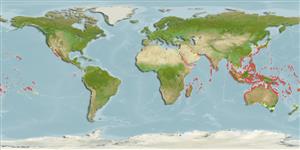Common names from other countries
Environment: milieu / climate zone / depth range / distribution range
Ecologia
; intervalo de profundidade 1 - 40 m (Ref. 118675). Tropical
Indo-Pacific: from Red Sea to Cocos Island, Costa Rica, Japan to New Zealand. Tropical and temperate.
All reports of Charonia tritonis in the Mediterranean are Charonia variegata (Ref. 114477).
Length at first maturity / Tamanho / Peso / Idade
Maturity: Lm ? range ? - ? cm Max length : 50.0 cm SHL macho/indeterminado; (Ref. 114242)
Feeds on sea stars and sea urchins, including crown-of-thorns starfish (Ref. 122680).
Life cycle and mating behavior
Maturidade | Reprodução | Desova | Ovos | Fecundidade | Larvas
Members of the order Neotaenioglossa are mostly gonochoric and broadcast spawners. Life cycle: Embryos develop into planktonic trocophore larvae and later into juvenile veligers before becoming fully grown adults.
Smith, B.D. 2003. (Ref. 3116)
Categoria na Lista Vermelha da IUCN (Ref. 130435)
Categoria CITES (Ref. 108899)
Not Evaluated
Not Evaluated
Utilização humana
| FishSource |
Ferramentas
Mais informação
Idade/Tamanho
Crescimento
Comprimento-peso
Comprimento-comprimento
Morfologia
Larvas
Abundância
Fontes da internet
Estimates based on models
Preferred temperature
(Ref.
115969): 23.9 - 29.3, mean 27.9 (based on 1273 cells).
Categoria de preço
Unknown.
